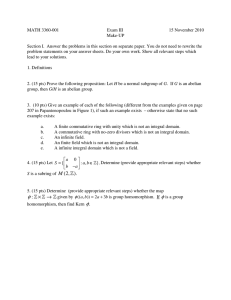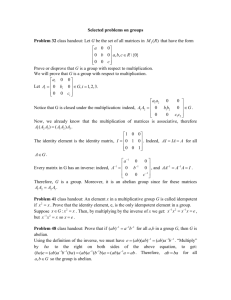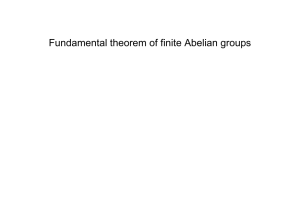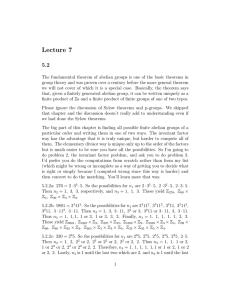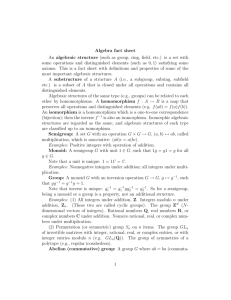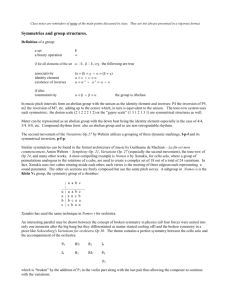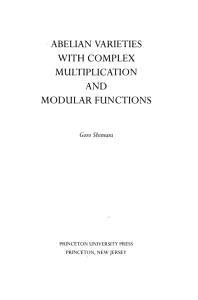Exercise 1
advertisement
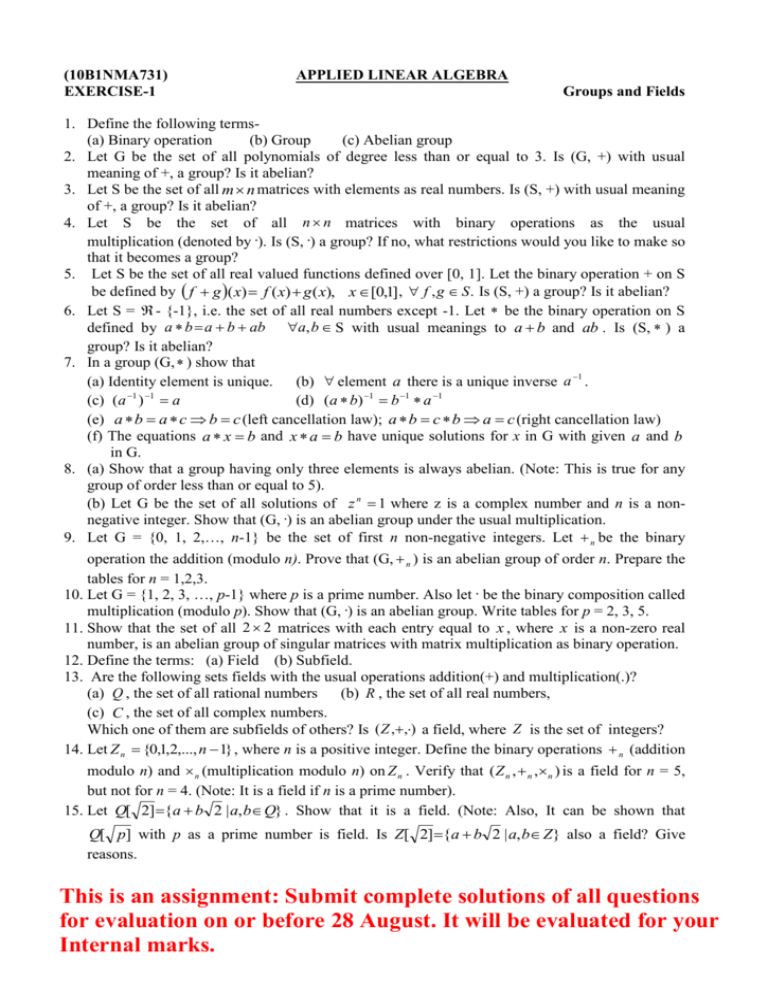
(10B1NMA731)
EXERCISE-1
APPLIED LINEAR ALGEBRA
Groups and Fields
1. Define the following terms(a) Binary operation
(b) Group
(c) Abelian group
2. Let G be the set of all polynomials of degree less than or equal to 3. Is (G, +) with usual
meaning of +, a group? Is it abelian?
3. Let S be the set of all m n matrices with elements as real numbers. Is (S, +) with usual meaning
of +, a group? Is it abelian?
4. Let S be the set of all n n matrices with binary operations as the usual
multiplication (denoted by .). Is (S, .) a group? If no, what restrictions would you like to make so
that it becomes a group?
5. Let S be the set of all real valued functions defined over [0, 1]. Let the binary operation + on S
be defined by f g ( x) f ( x) g ( x), x [0,1] , f , g S . Is (S, +) a group? Is it abelian?
6. Let S = - {-1}, i.e. the set of all real numbers except -1. Let be the binary operation on S
defined by a b a b ab a, b S with usual meanings to a b and ab . Is (S, ) a
group? Is it abelian?
7. In a group (G, ) show that
(a) Identity element is unique.
(b) element a there is a unique inverse a 1 .
(c) (a 1 ) 1 a
(d) (a b) 1 b 1 a 1
(e) a b a c b c (left cancellation law); a b c b a c (right cancellation law)
(f) The equations a x b and x a b have unique solutions for x in G with given a and b
in G.
8. (a) Show that a group having only three elements is always abelian. (Note: This is true for any
group of order less than or equal to 5).
(b) Let G be the set of all solutions of z n 1 where z is a complex number and n is a nonnegative integer. Show that (G, .) is an abelian group under the usual multiplication.
9. Let G = {0, 1, 2,…, n-1} be the set of first n non-negative integers. Let n be the binary
operation the addition (modulo n). Prove that (G, n ) is an abelian group of order n. Prepare the
tables for n = 1,2,3.
10. Let G = {1, 2, 3, …, p-1} where p is a prime number. Also let . be the binary composition called
multiplication (modulo p). Show that (G, .) is an abelian group. Write tables for p = 2, 3, 5.
11. Show that the set of all 2 2 matrices with each entry equal to x , where x is a non-zero real
number, is an abelian group of singular matrices with matrix multiplication as binary operation.
12. Define the terms: (a) Field (b) Subfield.
13. Are the following sets fields with the usual operations addition(+) and multiplication(.)?
(a) Q , the set of all rational numbers
(b) R , the set of all real numbers,
(c) C , the set of all complex numbers.
Which one of them are subfields of others? Is ( Z ,,) a field, where Z is the set of integers?
14. Let Z n {0,1,2,..., n 1} , where n is a positive integer. Define the binary operations n (addition
modulo n) and n (multiplication modulo n) on Z n . Verify that (Z n , n , n ) is a field for n = 5,
but not for n = 4. (Note: It is a field if n is a prime number).
15. Let Q[ 2] { a b 2 | a, b Q} . Show that it is a field. (Note: Also, It can be shown that
Q[ p] with p as a prime number is field. Is Z[ 2] { a b 2 | a, b Z} also a field? Give
reasons.
This is an assignment: Submit complete solutions of all questions
for evaluation on or before 28 August. It will be evaluated for your
Internal marks.
